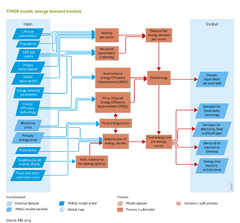Energy demand: Difference between revisions
Jump to navigation
Jump to search
Oostenrijr (talk | contribs) No edit summary |
Oostenrijr (talk | contribs) No edit summary |
||
| (One intermediate revision by the same user not shown) | |||
| Line 1: | Line 1: | ||
{{ComponentTemplate2 | {{ComponentTemplate2 | ||
|Application=Roads from Rio+20 (2012) project; EU Resource efficiency (2011) project; ADVANCE project; | |Application=Roads from Rio+20 (2012) project; EU Resource efficiency (2011) project; ADVANCE project; | ||
|IMAGEComponent= | |IMAGEComponent=Drivers; Human development; Forest management; | ||
|KeyReference=Daioglou et al., 2012; Girod et al., 2012; Van Ruijven et al., 2012; | |KeyReference=Daioglou et al., 2012; Girod et al., 2012; Van Ruijven et al., 2012; | ||
|InputVar=GDP per capita; Sector value added; Private consumption; Population; Energy intensity parameters; Energy efficiency technology; Primary energy price; Electricity price; Lifestyle parameters; Taxes and other additional costs; Preferences; | |InputVar=GDP per capita; Sector value added; Private consumption; Population; Energy intensity parameters; Energy efficiency technology; Primary energy price; Electricity price; Lifestyle parameters; Taxes and other additional costs; Preferences; Secondary energy price | ||
|Parameter=Exogenously set market shares; | |Parameter=Exogenously set market shares; | ||
|OutputVar=Demand for electricity, heat and hydrogen; Demand traditional biomass; People dependent on solid fuel; Energy and industry activity level; Demand for fossil fuels and bioenergy; | |OutputVar=Demand for electricity, heat and hydrogen; Demand traditional biomass; People dependent on solid fuel; Energy and industry activity level; Demand for fossil fuels and bioenergy; | ||
| Line 14: | Line 14: | ||
*price-based fuel substitution ( the choice of energy carrier on the basis of its relative costs). | *price-based fuel substitution ( the choice of energy carrier on the basis of its relative costs). | ||
These factors are implemented in different ways in the various sectors. In some sectors, a detailed end-use service-oriented modelling approach is used while in other sectors, the description is more generic and aggregate. Energy prices link the demand module with other parts of the energy model, as they respond dynamically to changes in demand, supply and conversion. | These factors are implemented in different ways in the various sectors. In some sectors, a detailed end-use service-oriented modelling approach is used while in other sectors, the description is more generic and aggregate. Energy prices link the demand module with other parts of the energy model, as they respond dynamically to changes in demand, supply and conversion. | ||
|ComponentCode=ED | |ComponentCode=ED | ||
|AggregatedComponent=Energy supply and demand | |AggregatedComponent=Energy supply and demand | ||
|FrameworkElementType=pressure component | |FrameworkElementType=pressure component | ||
}} | }} | ||
Revision as of 08:04, 1 August 2017
| Component is implemented in: |
|
| Related IMAGE components |
| Projects/Applications |
| Key publications |
Key policy issues
- How will energy demand evolve particularly in emerging and medium- and low-income economies?
- What is the mix of end-use energy carriers to meet future energy demand?
- How can energy efficiency contribute to reducing the growth rate of energy demand and mitigate pressures on the global environment?
